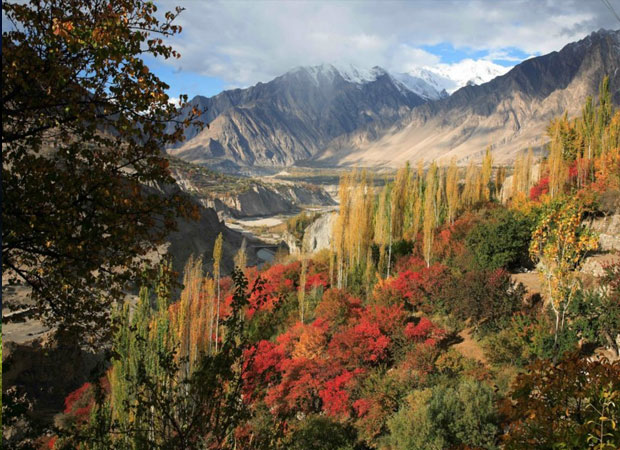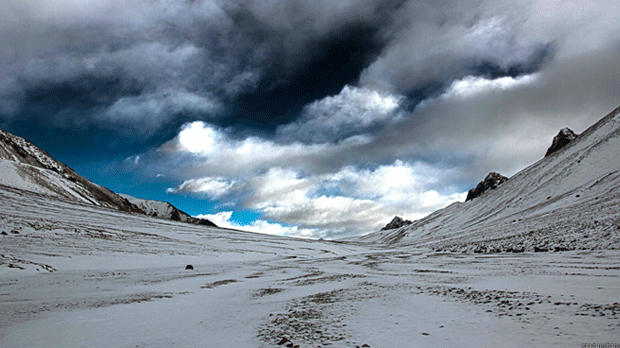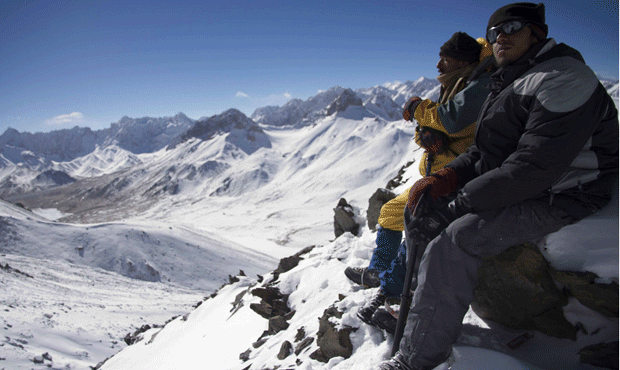|
Shimshal is a village located in Gojal, Hunza–Nagar
District, in the Pakistan-administered Gilgit–Baltistan formerly known
as Northern Areas of Pakistan. It lies at an altitude of 3,100 m above
sea level, and is the highest settlement in Hunza Valley of Pakistan. It
is the bordering village that connects Gilgit-Baltistan province of
Pakistan with China. The total area of Shimshal is 3,800 km2 and there
are around two thousand inhabitants with a total of two hundred and
forty households. Shimshal is made up of four major hamlets; Farmanabad,
Aminabad, Center Shimshal and Khizarabad. Farmanabad is a new settlement
that comes first on reaching Shimshal.
|
|
 |
|
Aminabad is announced by vast fields of stones hemmed in by dry stone
walls, and fortress-like houses of stone and mud. As you approach
Shimshal look for a glimpse of Odver Sar (6,303m) also known as Shimshal
Whitehorn. Shimshal has hydroelectricity from Odver stream for five
months (June–October) of the year (when the water isn't frozen). Non
availability of electricity for seven months is a big problem of the
local community because during this period they have to rely on kerosene
oil, firewood, solar plates and compressed natural gas in cylinders as
an alternative .
The village was inaccessible by motor road until October 2003, when a
new road from the Karakoram Highway at Passu was constructed. The
construction of non-metallic Jeep-able road started in 1985 and
completed in 2003. Eighteen years (1985-2003) of handwork finally become
successful because of hard work, dedication and self-help. It become
possible to connect Shimshal with rest of the world by mutual
cooperation of the Aga Khan Rural Support Programme, Government of
Pakistan and the local community. It now takes maximum three hours to
reach Shimshal by jeep from Passu. Self-help or Nomus ( in local Wakhi
language) is the major factor for infrastructure development in Shimshal.
Brock University Canada has recently launched a new project A Critical
Ethnography of the Shimshal Road.
|
|

|
|
Shimshalis use numerous seasonal mountain grasslands, located several
days walk from the village, to sustain herds of yaks, goats, and sheep.
The area was founded by Mamo Singh and his wife named Khudija.They have
the only son Sher. According to Shimshal's history and tradition, their
first child won the local polo game from Kargiz (Chinese) riding yak
while the Chinese rode horses.The Shimshal River comes from this area
and then transforms the shape of Hunza River, which mixes with the Indus
River below the capital city Gilgit.
The people of Shimshal are Wakhi and they speak the Wakhi language. They
belong to the Ismaili sect of Shia Islam.
The entire community is the follower of Aga Khan as their 49th spiritual
leader who is the direct descendant of Muhammad. The Ismaili Community.
Shimshal Pass (Ṣ̌ʉw Wʉrt) (4,735m) rises above the village. It lies on
the watershed between the Indus River and Tarim River basins, and leads
to the valley of the Shimshal Braldu River, a tributary of the Shaksgam
River on the border with China. Francis Younghusband was probably the
first Englishman to reach the pass (1889). At the time it was used by
raiders from Hunza to attack caravans traveling between Leh and Yarkand.
There was a fort manned by Hunza soldiers, or raiders, or both. The pass
is not part of Khunjerab National Park, but the Shimshal community has
set an organization called SNT (Shimshal Nature Trust) which oversees
the entire region and takes care of its own land. It is a community
based organization and is registered with the Government Of Pakistan.
|
|

|
|
Annually, in the last week of July or 1st week week of August, there is
a festival at Shimshal Pass, where locals partake in a yak race,
followed by singing and dancing. In Wakhi language it is called Woolyo.
This yak race is the only one of its kind, and is a unique event
organised at high mountain settlements of Pakistan .
Shimshal valley has its largest adventure area in Hunza and is a major
attraction for tourists. Its mountains like Destaghil Sar (7,885m),
Shimshal White Horn( 6,303m) Minglik Sar(6,150m), Lupghar
Sar(7200m),Yazghail Sar(6000m), Kunjut Sar and others are well known
among mountaineers. Gigantic glaciers include Malangudhi, Yazghail,
Khurdopin5800m , Braldu, Odver, Ver Zharav, and main passes are
Chafchingoal, Khurdopin, Mai Dur, Braldu, Boi Sam and others. Shimshalis
are to Pakistan as Sherpas are to Nepal. More than twenty well known
mountaineers from this valley have made Pakistan proud in the field of
tourism.
Some people call it " The Valley of Mountaineers". Some of them are
Rajab Shah, Mehrban Shah, Shambi Khan,Aziz Ullah, Qudrat Ali, Sarwar
Ali, Shaheen Baig, Ali Mussa, Amr Uddin Shah, Amin Ullah Baig, Sajjad
Karim, Aziz Baig, Qurban Muhammad, Tafat Shah, Farhad Khan, Wahab Ali
Shah, Fazl Ali, Hasil Shah,Yousaf Khan, Muhammad Ullah, Ezat Ullah,
Muhammad Bari, Shafa Ali, Muhammad Abdul,Saeed Ahmed,Jalal Uddin and
others. Rajab Shah has the distinction of scaling all five peaks more
than eight thousand meters located in Pakistan. Rajab Shah and Mehrban
Shah have received Presidential Award for Pride of Performance in
recognition of their extra ordinary achievement in the field of tourism
and mountaineering. |
|
|